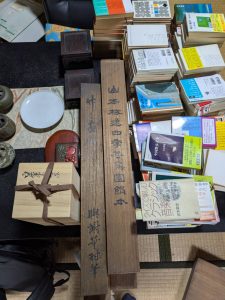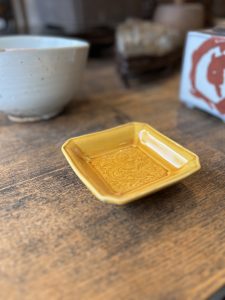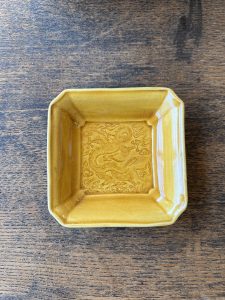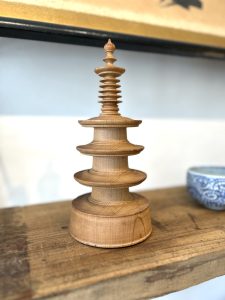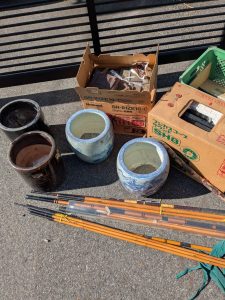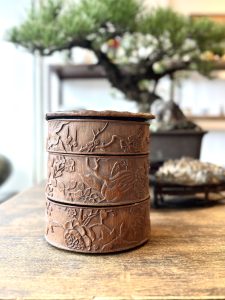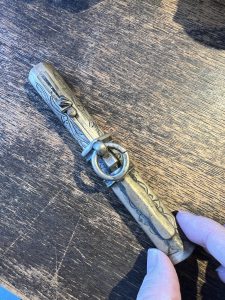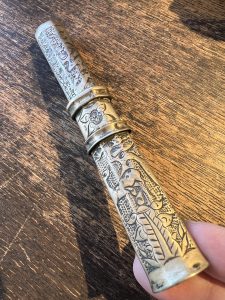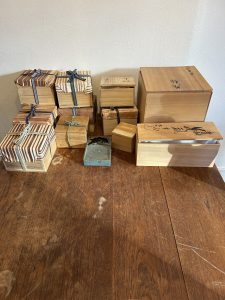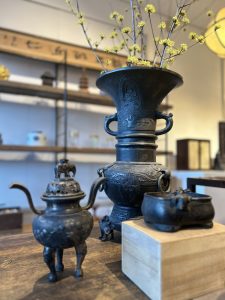もしかしたらバズるかしら・・・(愛知県名古屋市千種区姫池通 骨董買取 古美術風光舎)
2025.01.31
ふとラジオから聞こえてきた歌に耳が釘付けになりました。昭和を感じさせるメロディに男の生きるせつなさ、悲哀に満ちた歌詞。
これは、何?という感じで、調べてみたら…。
どうやら「北野誠のズバリ」というラジオ番組から生まれた、河原崎辰也氏の「家族になれない」でした。
替え歌ではなくオリジナルというのがまた秀逸。家族からメンバー外とされている夫・父親の悲劇エピソードを綴った歌詞で、男性にはあまりにも悲しすぎる歌詞なのですが、聞くとあるあると思うところもあって、ごめんなさい大爆笑してしまいました。「俺はただのATM~♪」うっかり口ずさんでしまいそうになりますので、ご興味ある方は聞いてみてください(笑)
その昔、「亭主元気で留守がいい」という1980年代のテレビCMで流れたキャッチコピーもありましたね。すべての奥様が同じように思っているわけではないでしょうが、流行語のひとつにも選ばれて、多くの女性にも共感されたのでしょう。
流行したのはバブル時代の初めで、仕事に励んで家庭を顧みる余裕がない夫が増えてきた時期。それに対して不満を述べるのではなく、自分も家庭で楽しく過ごすという奥様たちの本音を代弁するものだったともいえるかもしれませんね。
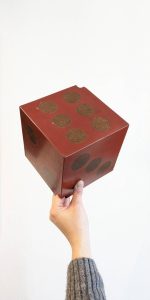
ところで皆さまは、普段ラジオは聞かれますか?
私はあまり聞かない方なのですが、スマホでラジオが気軽に聞けるようになったり、色々な音声アプリもあったりと選択肢が増えて、私の周りにもラジオを聞く人が増えているような気がします。コロナ禍でラジオを聴く機会が増えたり、在宅作業をしている人が仕事をしながら聴いたり、スマホやPCで手軽に聴けるアプリを利用しているようですね。
ラジオ離れなどと言われることもあるようですが、今の若者世代も利用する人は増えているよう。
いわゆるZ世代は、情報過多の時代ですから「タイパ」が重要(笑)。私には老いからかどうも慣れないですが、何でも倍速で見たりしますよね。ですので、自分の聴きたい時に○○しながら利用できるアプリは使い勝手がちょうど良いのかもしれませんね。
私がもう一つ気になっているのが、ながら聴きできる「オーディブル」です。
読書はしたいけれど、「時間」のせいで諦めている人にオススメ!と、友人に熱く勧められているのですが、「時間がない、新しく挑戦する勇気がない」と言い訳してなかなか踏み切れません。と、いろいろ言い訳してはみるものの、実は同時に二つのことが出来なかったりするからなのですが…。
お使いの方、ぜひ感想を聞かせていただきたいです。
ではでは、また。(スタッフT)
My ears were suddenly glued to a song I heard on the radio. The melody was reminiscent of the Showa period, and the lyrics were filled with the sadness and sorrow of a man’s life.
What is this? I looked it up and found out….
Apparently, it was “Kazoku ni narenai” by Tatsuya Kawarazaki, a song that originated from a radio program called “Makoto Kitano’s Zubari” (Makoto Kitano’s Zubari).
The fact that it is an original and not a dubbed song is also excellent. The lyrics are about tragic episodes of husbands and fathers who are excluded from the family, and the lyrics are too sad for men, but when I listened to them, I found myself laughing out loud, sorry to say. I’m just an ATM…” I almost accidentally hummed the lyrics, so if you are interested, please listen to them (laugh).
Once upon a time, there was a catchphrase that ran in a TV commercial in the 1980s, “Husband, be cheerful and stay at home,” wasn’t there? Not all wives may have felt the same way, but it was chosen as one of the most popular words and was probably shared by many women.
It became popular at the beginning of the bubble era, when more and more husbands were working hard and could not afford to take care of their families. It could be said that the radio program represented the true feelings of wives who wanted to enjoy their time at home, rather than expressing their dissatisfaction.
By the way, do you usually listen to the radio?
I don’t listen to the radio very often, but I feel that the number of people around me who listen to the radio is increasing as more and more people are able to listen to the radio easily on their smartphones and there are various audio apps to choose from. It seems that there are more opportunities to listen to the radio with the Corona Disaster, people who work from home listen to the radio while they work, and people are using apps that allow them to listen easily on their smartphones and PCs.
Although it is sometimes said that people are becoming less interested in radio, it seems that more and more of today’s youth generation is also using it.
The so-called Generation Z is in an age of information overload, so “typa” is important (laughs). I am not used to it, perhaps because of my old age, but they watch everything at double speed, don’t they? So an application that I can use while ____ when I want to listen may be just right in terms of usability.
I am interested in “audible,” which allows you to listen while you listen.
I recommend it to those who want to read but have given up because of “time”! I have a friend who enthusiastically recommends it to me, but I have a hard time taking the plunge, making excuses like “I don’t have time” and “I don’t have the courage to try something new.
I try to make excuses, but the truth is that I can’t do two things at the same time….
I would love to hear your thoughts on this.
See you soon. (Staff T)
*****************
ご実家の整理やお片付けなどをされている方のご相談などが多くございます。
お片付けなどくれぐれもご無理のないようになさってくださいませ。
風光舎では古美術品や骨董品の他にも絵画や宝石、趣味のお品など様々なジャンルのものを買受しております。
お片付けをされていて、こういうものでもいいのかしらと迷われているものでも、どうぞお気軽にご相談下さいませ。
また風光舎は、出張買取も強化しております。ご近所はもちろん、愛知県内、岐阜県、三重県その他の県へも出張いたします。
まずは、お電話お待ちしております。
愛知県名古屋市千種区姫池通
骨董 買取【古美術 風光舎 名古屋店】
TEL052(734)8444
10:00-18:00 OPEN
#出張買取#骨董#古美術#骨董品#絵画#版画#茶道具#刀剣#彫刻

